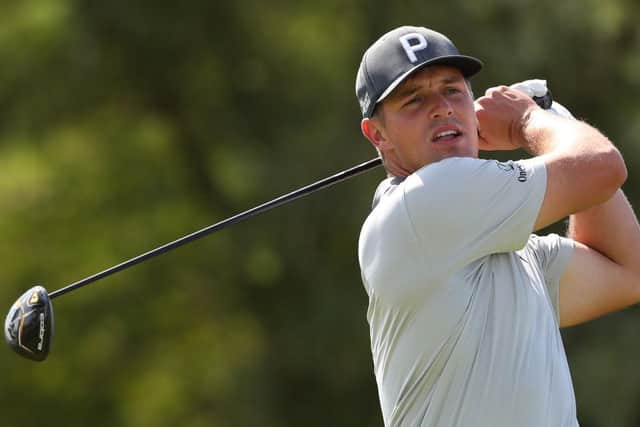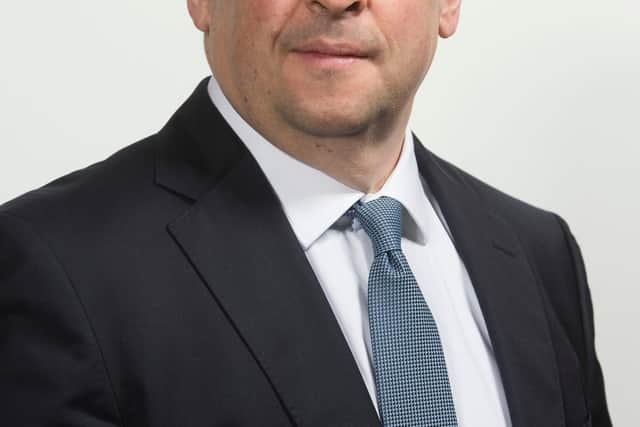Golf's governing bodies come up with 'hybrid' plan in bid to find club and ball solution
In the latest announcement about an ongoing review of hitting distance by the R&A and USGA, it has been decided that the governing bodies will increase ball test speeds achieved by the likes of Bryson DeChambeau in a bid to “investigate” the potential impacts on courses as they continue to be overpowered.
This will involve clubhead speeds being increased to at least 125mph, but, at the same time, an effort is also now being made to “minimise the impact” of any action that might be taken to rein in driving distance for shorter hitters with slower swing speeds at club level.
Advertisement
Hide AdAdvertisement
Hide AdThrough investigating the impact of a reduction of the allowable spring-like effect and moment of inertia in drivers, Model Local Rules could be utilised to both curb big-hitting at the top level of the game but also allow recreational golfers to keep enjoying “modest distance increases”.


“At a very headline level, it’s about achieving more engagement with the industry then you’ve got what would happen if these measures came in,” Professor Steve Otto, The R&A’s Executive Director – Equipment Standards, told The Scotsman of the latest announcement.
“It’s a complex problem that needs a complex solution. It’s difficult to understand, but it needs to be as we are trying to satisfy a lot of different aspects here. We are trying to look at hitting distance at the very elite end, we are trying to look at what that means for recreational golfers.
“There are nods to opening up innovation to them. It’s not as simple as some people indicate and say ‘you just do this’. We’ve done lots of research on what we expect might happen and this hybrid of looking at a ball and club solution, we think is best for the industry.
“We think it can be used as a way of providing choice to the industry and say ‘let’s address the potential issues with hitting distance at the long end of the game but perhaps open up innovation at the shorter end to keep people interested’ rather than just applying a wholesale blanket and change it for everyone’.”


Released in 2020, the Distance Insights Report from the R&A and USGA identified a long-term cycle of hitting distance increases and lengthening courses that the governing bodies concluded was “detrimental to golf and the way it is played”.
Golf’s stakeholders can provide feedback and research on the latest topics by 2 September 2022, but Otto, a former NASA scientist, warned that the process could still have a long way to go.
“This isn’t a short and quick thing we are doing here,” he added. “We’ve got to get this right and we are going to do it in a considered and collaborative way with the industry and this is the next stage in engaging in those conversations.
Advertisement
Hide AdAdvertisement
Hide Ad“There are a lot of very intelligent students of the game, whether it be people in the media or within the manufacturing community or people who own and operate golf courses. This is about engaging with everyone and bringing everyone together into that discussion.
“Even when we get to September, depending on the interaction with the industry, we will still have a way to go. Even if we were to say we are going to change this now, there’s a long period of implementation.
“What these kinds of communications allow us to do is have more in-depth and detailed conversations with people. For instance, now we can go out and be testing with tour pros. We can go out on the range and look at the way the equipment might be going in the future.”
Has the engagement so far from the manufacturers been encouraging? “They may not like the ultimate direction, but they want to be engaged,” said Otto. “They see that sort of North Star of ensuring that the game is surely going to be thriving 50 years in the future as something we can all agree on.
“We may differ on the short-term solutions and moves, but actually looking at the long-term future and sustainability of the game is absolutely core for everyone that is involved.”
Otto showed his sense of humour when asked how much of his time was taken up by the distance debate. “Over the last 20 years, it’s probably taken 25 years of my life away,” he replied, laughing.
“Seriously, though, it is something that is absolutely critical. We have invested in Kingsbarns (where the R&A has a testing facility). We’ve invested in more staff, more knowledge on research and on data.
“It’s less about my time and more about an investment by the organisation and the USGA into making sure that we base our decisions on good data that comes not only from our testing but also research that comes from others.
Advertisement
Hide AdAdvertisement
Hide Ad“It excites me because it is about being able to have those conversations. I started with the R&A back in 1998, when I came on to a project on the spring-like effect on drivers, which was about how far the clubs were hitting it back then.
“It feels as though there has been a real sort of momentum change in that I think we can get something done through this process, but we are going to do it with the industry and bring people with us and have that informed discussion with the students of the game, people who understand about the physics of things and understand about the interactions.
“It’s not a simple process, but it’s one that I’m excited to be talking to people in a more informed way in the coming months and years.”
Get a year of unlimited access to all The Scotsman's sport coverage without the need for a full subscription. Expert analysis of the biggest games, exclusive interviews, live blogs, transfer news and 70 per cent fewer ads on Scotsman.com - all for less than £1 a week. Subscribe to us today
Comments
Want to join the conversation? Please or to comment on this article.

